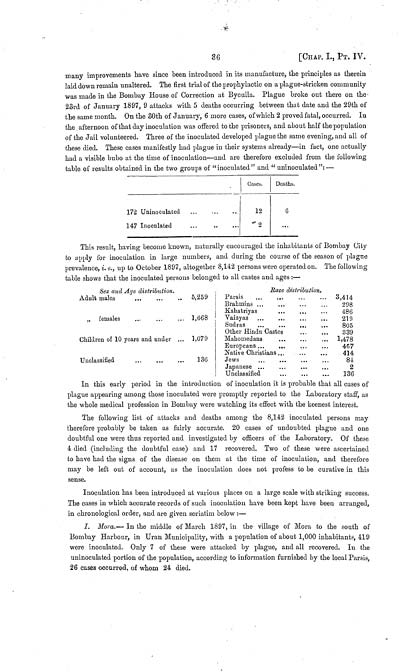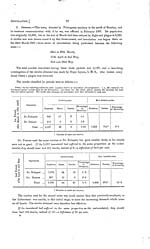Medicine - Disease > Bombay plague: being a history of the progress of plague in the Bombay presidency from September 1896 to June 1899
(66) Page 36
Download files
Individual page:
Thumbnail gallery: Grid view | List view

36 [CHAP. I., ?T. IV.
many improvements have since been introduced in its manufacture, the principles as therein
laid down remain unaltered. The first trial of the prophylactic on a plague-stricken community
was made in the Bombay House of Correction at Byculla. Plague broke out there on the-
23rd of January 1897, 9 attacks with 5 deaths occurring between that date and the 29th of
the same month. On the 30th of January, 6 more cases, of which 2 proved fatal, occurred. In
the afternoon of that day inoculation was offered to the prisoners, and about half the population
of the Jail volunteered. Three of the inoculated developed plague the same evening, and all of
these died. These cases manifestly had plague in their systems already-in fact, one actually
had a visible bubo at the time of inoculation-and are therefore excluded from the following
table of results obtained in the two groups of "inoculated" and " uninoculated": -
Cases.
Deaths.
172 Uninoculated
12
6
147 Inoculated
2
...
This result, having become known, naturally encouraged the inhabitants of Bombay City
to apply for inoculation in large numbers, and during the course of the season of plague
prevalence, ?. e., up to October 1897, altogether 8,142 persons were operated on. The following
table shows that the inoculated persons belonged to all castes and ages :-
Sex and Age distribution.
Race distribution.
Adult males ...... 5,259
Parsis 3,414
Brahmins 298
Kshatriyas 486
females 1,668
Vaisyas 219
Sudras 805
Other Hindu Castes 339
Children of 10 years and under 1,079
Mahomedans 1,478
Europeans ...... 467
Native Christians 414
Unclassified 136
Jews 84
Japanese 2
Unclassified 136
In this early period in the introduction of inoculation it is probable that all cases of
plague appearing among those inoculated were promptly reported to the Laboratory staff, as
the whole medical profession in Bombay were watching its effect with the keenest interest.
The following list of attacks and deaths among the 8,142 inoculated persons may
therefore probably be taken as fairly accurate. 20 cases of undoubted plague and one
doubtful one were thus reported and investigated by officers of the Laboratory. Of these
4 died (including the doubtful case) and 17 recovered. Two of these were ascertained
to have had the signs of the disease on them at the time of inoculation, and therefore
may be left out of account, as the inoculation does not profess to be curative in this
sense.
Inoculation has been introduced at various places on a large scale with striking success.
The cases in which accurate records of such inoculation have been kept have been arranged,
in chronological order, and are given seriatim below :-
I. Mora.- In the middle of March 1897, in the village of Mora to the south of
Bombay Harbour, in Uran Municipality, with a population of about 1,000 inhabitants, 419
were inoculated. Only 7 of these were attacked by plague, and all recovered. In the
uninoculated portion of the population, according to information furnished by the local Parsis,
26 cases occurred, of whom 24 died.
many improvements have since been introduced in its manufacture, the principles as therein
laid down remain unaltered. The first trial of the prophylactic on a plague-stricken community
was made in the Bombay House of Correction at Byculla. Plague broke out there on the-
23rd of January 1897, 9 attacks with 5 deaths occurring between that date and the 29th of
the same month. On the 30th of January, 6 more cases, of which 2 proved fatal, occurred. In
the afternoon of that day inoculation was offered to the prisoners, and about half the population
of the Jail volunteered. Three of the inoculated developed plague the same evening, and all of
these died. These cases manifestly had plague in their systems already-in fact, one actually
had a visible bubo at the time of inoculation-and are therefore excluded from the following
table of results obtained in the two groups of "inoculated" and " uninoculated": -
Cases.
Deaths.
172 Uninoculated
12
6
147 Inoculated
2
...
This result, having become known, naturally encouraged the inhabitants of Bombay City
to apply for inoculation in large numbers, and during the course of the season of plague
prevalence, ?. e., up to October 1897, altogether 8,142 persons were operated on. The following
table shows that the inoculated persons belonged to all castes and ages :-
Sex and Age distribution.
Race distribution.
Adult males ...... 5,259
Parsis 3,414
Brahmins 298
Kshatriyas 486
females 1,668
Vaisyas 219
Sudras 805
Other Hindu Castes 339
Children of 10 years and under 1,079
Mahomedans 1,478
Europeans ...... 467
Native Christians 414
Unclassified 136
Jews 84
Japanese 2
Unclassified 136
In this early period in the introduction of inoculation it is probable that all cases of
plague appearing among those inoculated were promptly reported to the Laboratory staff, as
the whole medical profession in Bombay were watching its effect with the keenest interest.
The following list of attacks and deaths among the 8,142 inoculated persons may
therefore probably be taken as fairly accurate. 20 cases of undoubted plague and one
doubtful one were thus reported and investigated by officers of the Laboratory. Of these
4 died (including the doubtful case) and 17 recovered. Two of these were ascertained
to have had the signs of the disease on them at the time of inoculation, and therefore
may be left out of account, as the inoculation does not profess to be curative in this
sense.
Inoculation has been introduced at various places on a large scale with striking success.
The cases in which accurate records of such inoculation have been kept have been arranged,
in chronological order, and are given seriatim below :-
I. Mora.- In the middle of March 1897, in the village of Mora to the south of
Bombay Harbour, in Uran Municipality, with a population of about 1,000 inhabitants, 419
were inoculated. Only 7 of these were attacked by plague, and all recovered. In the
uninoculated portion of the population, according to information furnished by the local Parsis,
26 cases occurred, of whom 24 died.
Set display mode to: Large image | Zoom image | Transcription
Images and transcriptions on this page, including medium image downloads, may be used under the Creative Commons Attribution 4.0 International Licence unless otherwise stated. ![]()
| India Papers > Medicine - Disease > Bombay plague: being a history of the progress of plague in the Bombay presidency from September 1896 to June 1899 > (66) Page 36 |
|---|
| Permanent URL | https://digital.nls.uk/74586100 |
|---|---|
| Description | Chap. I., Pt. IV. Evacuation. |



![Page [35]](https://deriv.nls.uk/dcn4/7444/74448570.4.jpg)
